general information
The blood circulating in the body, thanks to the branched vascular system, penetrates into all cells and tissues. Its volume depends on body weight and is about seven percent of it. Blood contains plasma and formed particles. The quantitative content of the latter is studied based on the results of a general analysis. Ninety percent of plasma consists of water; in addition, it contains amino acids, salts, proteins, and breakdown products of protein substances. A biochemical blood test shows that a malfunction has occurred in the functioning of one or another organ or, conversely, that all organs and systems are functioning normally.
In the blood, in addition to nutrients, there are waste products of cellular tissue that leave the body through the sweat glands, kidneys, liver, gastrointestinal tract, as well as substances formed as a result of the pathological process. Changes in the blood occur much earlier than the first symptoms of the disease appear. This type of research provides invaluable assistance in diagnosing many diseases, including identifying them in the early stages.
Preparing for a biochemical blood test in adults
For any type of examination, including blood biochemistry, you must carefully prepare. To do this, follow a few simple recommendations:
- For three days, give up fatty, spicy, spicy, sweet foods, canned food and pickles, strong tea and coffee drinks.
- After the last meal, at least twelve hours must pass before the biomaterial is submitted.
- One day before, avoid visiting the sauna or bathhouse, exercise, and, if possible, eliminate emotional stress.
- Avoid drinking alcoholic beverages the day before.
- An hour before the procedure - smoking.
- On the day of the test, do not drink or eat. Blood is drawn in the morning on an empty stomach.
- Physiotherapeutic manipulations, massage, and medication should be rescheduled (in consultation with the doctor). You can perform them after donating blood.
The results of a biochemical blood test will be ready in a day or two.
Indications for the study and preparation
Above we briefly listed the main directions of the body’s vital activity, which can be determined using conventional or advanced biochemical analysis. But usually a biochemistry test is prescribed for very specific indications. When does this happen? Most often, when the patient has main complaints, and the doctor suspects a dysfunction of any organs. This has been shown most convincingly in relation to liver disorders and especially in relation to increased bilirubin concentrations.
The second indication is to monitor treatment and identify various side effects from the use of medications. Thus, in modern clinical practice, statins, or drugs to reduce cholesterol in the blood plasma, have been successfully used for a long time. But during statin therapy, and especially if the patient has chronic liver disease, liver or kidney failure, a monthly check of liver and kidney function is required, and primarily the level of bilirubin and transaminases.
If during treatment there is a significant increase in the concentration of enzymes, then it is necessary to either reduce the dose or temporarily discontinue this drug.
Finally, the vast majority of these routine biochemical tests are performed either during hospitalization or during a preventive examination at the workplace or upon hiring. Most often, during medical examinations, they are tested for glucose and cholesterol.
No special preparation is required for a biochemical blood test. The usual conditions are mandatory blood donation on an empty stomach, after the usual period of overnight fasting, which should last from 8 to 14 hours. Usually, the doctor may not talk at all about the conditions for taking a biochemical blood test; they are automatically implied.
Of course, it is never a bad idea to ask whether a fasting blood test is performed or not. But, as a rule, it should be carried out on an empty stomach, regardless of whether it is a regular or extended research program. There are a few exceptions to this rule, when it comes to donating certain adrenal hormones, or donating blood for a chromosomal study such as karyotype. But this type is not a biochemical analysis, and the geneticist you prescribe must separately emphasize the conditions for donating blood.
How many days does a biochemical blood test take? Since laboratory biochemistry tests are usually carried out on the same day on which the biological material was collected, most often they are completed within a day or two, and sometimes the answer is ready by the evening of the day of blood collection. This is one of the shortest turnaround times in all laboratory diagnostics, especially if it is performed in a commercial laboratory and the finished analysis is sent by email. In each specific case, how much a particular analysis is performed must be clarified with the laboratory assistant or laboratory administrator.
Indications for blood biochemistry
The study is indicated when undergoing a preventive examination, clinical observation, registration at the antenatal clinic due to pregnancy, or an individual’s complaints about deterioration in health when visiting the clinic. Blood biochemistry is also prescribed in the following cases:
- suffered strokes, heart attacks;
- cerebral ischemia;
- IHD;
- hypercholesterolemia;
- pancreatitis;
- cholecystitis;
- stomach ulcer;
- enteritis;
- gastritis;
- menstrual irregularities;
- myoma;
- inflammatory process in the uterus;
- endometriosis;
- diabetes;
- obesity;
- neoplasm in the pituitary gland;
- and other.
In some cases, additional examination methods are required to confirm the diagnosis.
Blood biochemistry indicators in adults
Using this analysis, you can examine a fairly large number of indicators. In each specific case, the required set is determined by the attending doctor. The results obtained are compared with the norm. Deciphering a biochemical blood test in adults involves assessing and comparing the following parameters:
- Glucose and fructosamine are indispensable for assessing carbohydrate metabolism.
- Bile acids, bilirubin.
- Triglycerides, cholesterol, apoliproprotein are indicators of lipid and lipoprotein metabolism.
- Protein. Protein metabolism is assessed based on the analysis of total protein, urea, albumin, creatinine and uric acid. Among the specific proteins tested are transferrin, myoglobin, troponin, ferritin, and C-reactive protein.
- Phosphotase, lipase, amylase.
- Microelements.
- Vitamins.
Deviation of indicators from acceptable values in one direction or another signals a pathological process. Correct interpretation of a biochemical blood test in adults helps in making a diagnosis and also allows you to prescribe timely treatment. Below we will consider in more detail the reasons for the deviation of some indicators from acceptable values.
Standards for BAC indicators
In medicine, the norms for the main components have long been determined, which are shown by a biochemical blood test. They may differ somewhat in their scope. This depends on the gender and age of the patient. We will present the norms of blood biochemistry in adults after 18 years of age, and we will note the indicators of children only if there are significant differences.
| Analysis indicator | Established standards | Note |
| Total protein | from 64 to 83 g/l | from 58 to 76 in children |
| Albumen | from 35 to 50 g/l | from 38 to 54 in children |
| Myoglobin | from 19 to 92 mcg/l – men, from 12 to 76 – women. | from 38 to 54 in children |
| Transferrin | from 2.0 to 4.0 g/l | rates decrease slightly in the elderly and pregnant women |
| Ferritin | from 20 to 250 mcg/l – men, from 12 to 76 – women. | |
| OZhSS | from 26.85 to 41.2 mmol/l | |
| SRB | up to 0.5 mg/l | |
| Rheumatoid factor | up to 10 units/ml | |
| Cholesterol | up to 5.2 mmol/l | |
| Triglycerides | from 0.55 to 1.65 mmol/l | These indicators are very conditional |
| Urea | from 2.5 to 8.3 | from 1.8 to 6.4 in children |
| Creatine | from 62 to 115 – male, from 53 to 97 mmol – female. | from 27 to 62 – in children |
| Uric acid | from 0.24 to 0.50 mmol/l – male, from 0.16 to 0.44 – female. | 0.12 – 0.32 – in children |
| Bilirubin | ||
| general | 3.4 17.1 µmol/l | |
| connected | 25% of total | |
| free | 75% of total | |
| Glucose | 3.89 – 5.83 mol/l | from 3.33 to 5.55 – in children |
| Fructosamine | up to 280 mmol/l | |
| ASAT (Aspartate aminotransferase) | up to 35 – men, up to 31 U/l – women. | |
| ALT (Alanine aminotransferase) | up to 41 – men, up to 31 U/l – women. | |
| Alkaline phosphatase | from 20 to 130 U/l | from 130 to 600 – in children |
| a-amylase | up to 120 U/l | up to 30 U/l in infants up to one year old |
| Lipase | from 0 to 417 U/l | |
| QC and KFK | up to 195 U/l – men, up to 170 – women. | |
| MV-Faction KK | up to 10 U/l | |
| LDH | from 120 to 240 U/l | In children, norms depend on age |
| GGTP | from 11 to 50 U/l – men, from 7 to 32 – women. | |
| Sodium | from 134 to 150 mmol/l | |
| Potassium | from 3.6 to 5.4 mmol/l | |
| Chlorides | from 95 to 110 mmol/l | |
| Phosphorus | from 0.65 to 1.3 mmol/l | |
| Magnesium | from 0.65 to 1.1 mmol/l | |
| Iron | from 11.64 to 30.43 mmol/l – husband from 8.95 to 30.43 – women | |
| Calcium | from 2.0 to 2.8 mmol/l | |
| Zinc | from 11 to 18 mmol/l | up to 24 in children |
It is important to note here that, having received the results in hand, the patient may not see some of the above points. This will be the result of the attending physician not indicating a number of tests, since these values in this particular case do not have any significance and, based on the patient’s condition, are most likely to be normal.
Total protein (unit – g/l)
In an adult, the normal level of total protein is up to 83 in both men and women. This indicator indicates the total amount of protein substances in the blood that take part in many biochemical processes:
- act as catalysts for various chemical transformations;
- protect the body from infections;
- carry out a transport function.
The most common causes of increased protein in the blood:
- oncology;
- joint inflammation;
- rheumatic diseases.
Low levels of total protein in a biochemical blood test in adults indicate liver disease, kidney disease, intestinal pathology and the presence of malignant neoplasms.
Albumin is the main protein in blood plasma produced by the liver. Its low level occurs in cirrhosis, chronic hepatitis, heart failure, sepsis, and drug poisoning. High concentrations are typical for dehydration, extensive burns and prolonged diarrhea.
What can't be determined?
Of course, we have only listed a very small number of compounds that can be determined using a blood chemistry test. With the help of biochemical studies, various sex hormones and hormones of the adrenal glands and thyroid gland, which are of great importance for women's and men's health, are determined; tumor markers and various phospholipids are studied.
But there are also data that cannot be determined by this study. Thus, a biochemical blood test does not replace a general analysis. A biochemical blood test will not show the total number of blood cells or the content of different types of leukocytes. It is impossible to determine ESR and find out the ratio of the liquid part of the blood to the formed elements, or hematocrit.
Blood oxygen saturation, or oxygenation, cannot be determined. The table of biochemical blood test norms will not show how many eosinophils and how many neutrophils are in the blood. It is impossible to determine and identify the presence of infection in the blood using biochemical research methods and to isolate this pure culture of the pathogen. How to decipher a biochemical analysis for the strength of the immune system? No way either. He's not suitable for this. There are other ways to do this. But if we are talking about molecules and compounds dissolved in the blood plasma, and not about cells or pathogens, then the biochemical method will be in full demand. How to prepare for a biochemical blood test and why is it needed?
Glucose (unit of measurement – mmol/l)
The norm for an adult is from 3.8 to 5.8. An elevated level of this biochemical blood test indicator is observed when:
- diabetes mellitus;
- cystic fibrosis;
- hemorrhagic stroke;
- neoplasm in the pancreas.
Short-term excess is possible with overeating, stress and consumption of sweets in large quantities. Low blood glucose levels are observed in the following pathological conditions:
- cancer of the adrenal glands, stomach;
- hypothyroidism;
- poisoning from alcoholic beverages and medications;
- liver diseases;
- inflammatory diseases of the pancreas.
Research of certain indicators
Just an abstract name, like “I was prescribed a biochemical analysis” does not tell a specialist anything. These words can only confirm the very fact of the patient’s visit to the laboratory at certain hours, but nothing more. But the phrase “I was prescribed a repeat biochemical glucose test because last time it was high” has a certain meaning and carries important information. Unfortunately, many people ignorant of medicine who come to take a biochemical analysis do not at all suspect which substances are needed by the attending physician, they do not study the direction.
They do not suspect that in the laboratory, at the doctor’s request, they are examined for the concentration of total protein, rheumatoid factor or total cholesterol levels. They are convinced that they are taking a “biochemical blood test”, and this is just one thing - a single study, and it has a certain result. Such people have a habit of asking extremely general questions that are difficult to give an exact answer, for example, “what does a biochemical test of blood from a vein show.”
Of course, this is not at all true, any study determines some kind of compound, but a detailed (advanced) biochemical blood test can show several dozen characteristics at once. Therefore, never forget the direction for research. If you simply tell the laboratory technician that you need to determine the indicators of a biochemical blood test, you will resemble a person who persistently demands to serve him food in a restaurant, but is not able to specifically order a single dish.
Cholesterol (unit of measurement – mmol/l)
This substance is an important component of lipid metabolism, actively participating in the production of vitamin D and various steroid hormones by the adrenal glands and the formation of cell membranes. Define:
- total cholesterol, the norm of which is the same for both sexes and ranges from 3 to 6;
- HDL and LDL, their acceptable values are different in women and men in a biochemical blood test.
High cholesterol is present when:
- obstructive jaundice;
- atherosclerosis;
- hepatitis in the chronic stage;
- decompensated diabetes mellitus;
- hypothyroidism.
Low concentration is a consequence of:
- prolonged fasting;
- liver cirrhosis;
- lung diseases (COPD);
- malignant neoplasms in the liver;
- rheumatoid arthritis;
- metabolic failure.
The influence of pregnancy on test results
As you know, during pregnancy a woman’s body undergoes global changes. Pregnant women have their own norms for indicators in biochemical blood tests, which differ significantly from the norms for other patients. During pregnancy, the following indicators change:
- Albumin can either decrease or increase.
- Globulin increases by the third trimester.
- Urea levels decrease by the third trimester.
- Creatinine also decreases closer to childbirth.
- On the contrary, phosphotase may increase by the third trimester.
- Potassium may also decrease slightly closer to the birth of your baby.
- Magnesium in pregnant women may be reduced, but this is considered normal.
- Iron in pregnant women always decreases slightly.
The remaining parameters of the biochemical blood test in expectant mothers should be stable. In this case, we can talk about the normal course of pregnancy and the birth of a healthy child.
Bilirubin (measurement unit – µmol/l)
This substance is a red-yellow pigment that is formed as a result of the breakdown of hemoglobin in the bone marrow, liver and spleen. The reasons for the high level of bilirubin in a biochemical blood test, the norm of which is from 3.4 to 17.1 for men and women, are:
- cholelithiasis;
- liver oncology;
- acute cholecystitis;
- cholangitis.
Low bilirubin levels are characteristic of drug poisoning, acute or toxic hepatitis, and liver disease due to bacterial infection.
Enzyme content
Enzymes are catalysts in the blood. They speed up metabolic processes, while each one performs work in a specific organ. A blood test for enzymes makes it possible to evaluate the chemical processes of the digestive system.
| Index | Norm |
| AlAT | 0.1-068 µmol/(h*ml) |
| ASAT | 0.1-0.45 µmol/(h*ml) |
| Alpha amylase | 12-32 mg/(h*ml) |
| Alkaline phosphatase | The content rate can vary within very wide limits; it depends on the method of determining the enzyme. The standard is set by the doctors conducting the study. |
ALT or alanine aminotransferase
An increase in ALT in the blood (alanine aminotransferase) can be monitored during liver destruction due to various infections, hepatitis C, and toxic lesions. The degree of the disease can be tracked by the degree of excess of the norm.
AST or aspartate aminotransferase
By measuring aspartate aminotransferase, you can learn about the condition of the liver and heart muscle. An increased level of AST in the blood plasma indicates the pathology of these organs. An isolated increase means the occurrence of myocardial infarction. In turn, a synchronous increase in this enzyme reveals hepatic cytolysis in liver damage.
Alpha amylase
Alpha amylase shows the significance of the enzyme activity of the pancreas. In the case of this indicator, the result depends on both the increase and decrease in its level in the blood.
Elevated levels of alpha-amylase indicate some kind of inflammation associated with chronic or acute pancreatitis, destruction of pancreatic tissue, also known as pancreatic necrosis, a violation of the outflow of pancreatic juice from the pancreas associated with bile duct stones, or tumor transformation.
The reason for the decrease in amylase levels is the transfer of total or subtotal pancreatic necrosis, as well as operations to remove all or some part of the pancreas.
Alkaline phosphatase
Alkaline phosphatase is often included automatically in a biochemical blood test. In practice, as a result, only the increased activity of this enzyme is important. This usually occurs with intrahepatic stagnation of bile in the bile ducts, or progressive osteoporosis, destruction of bone tissue (the reason for this is aging of the body or multiple myeloma).
Minerals: sodium
This element maintains osmotic pressure in cells and tissues in the individual’s body, as well as the physiological level of acidity. Its level is controlled by the hormonal substance of the adrenal cortex. With edema, heart failure, diabetes mellitus, and the use of large amounts of diuretics, low sodium levels in the blood are observed. Elevated levels are present in the following conditions:
- diabetes insipidus;
- pathology of the hypothalamus;
- prolonged diarrhea;
- vomit;
- coma.
Biochemical blood test in women
In women and men, acceptable blood biochemistry values differ.
This is primarily due to hormonal instability during different periods of life in women. During the research process, the laboratory identifies more than forty blood parameters that help identify disturbances in the functioning of organs and systems. The following indicators are analyzed:
- Total protein. A low amount indicates insufficient intake from food. A change in this value from the norm signals the occurrence of pathological processes in the liver, gastrointestinal tract, kidneys or connective tissue.
- Ferritin. A low level indicates infection, neoplasm, rheumatism.
- Transferrin. If liver function is impaired, this indicator undergoes changes.
- Albumen. It can be used to determine liver and kidney diseases.
- Myoglobin. In case of injuries, burns or convulsions, an overestimated amount is detected.
- Ceruloplasmin. An increase above normal indicates the presence of malignant tumors, inflammation and myocardial infarction.
- Rheumatoid factor. Changes in this parameter are observed in mononucleosis, tuberculosis, infective endocarditis, and rheumatoid arthritis.
- C-reactive protein. When inflammatory processes occur in the body, this parameter increases.
- Lipid spectrum: LDL, HDL, triglycerides, total cholesterol. Interpretation of the results of a biochemical blood test allows one to identify cardiac pathologies.
- The enzyme group helps detect malfunctions of the liver and pancreas: ALT, AST, A-amylase, lipase, cholinesterase, creatinine kinase, gamma-glutamyl transpeptidase, lactate dehydrogenase, alkaline phosphatase.
- Glucose. This parameter is used to detect diabetes mellitus.
- Bilirubin. Its deviation from normal values occurs in various hepatitis, anemia, cholelithiasis, tumors in the pancreas and liver, and diseases of the biliary tract.
- Creatinine. If it fluctuates, diabetes mellitus, damage to the adrenal glands, kidneys and liver are suspected.
- Urea. This parameter helps to identify diseases of the digestive system, kidney failure and liver pathologies.
- Microelements, vitamins, acids.
Blood biochemistry during pregnancy
Carrying out this type of research allows you to get an idea of the water-electrolyte, carbohydrate metabolism process, as well as the amount of microelements. A biochemical blood test helps determine the functional state of all body systems in a pregnant woman. During this period, a huge load is placed on the endocrine system, heart, kidneys and liver, so monitoring the activity of these organs is very important.
During a normal pregnancy, expectant mothers take this test twice:
- When registering at the antenatal clinic. During the initial examination, changes that occurred in the body before conception are revealed.
- After 30 weeks after the previous analysis, it is prescribed again for prophylactic purposes.
In addition, a biochemical blood test is indicated in the following cases:
- assessment of therapy in the presence of complications during pregnancy;
- control over existing concomitant diseases;
- dispensary observation in a day or 24-hour hospital setting.
The biomaterial is collected from a vein. The number of indicators that need to be analyzed is determined by the doctor individually. It must be remembered that the permissible values of certain blood characteristics depend on the period of pregnancy and differ from the norm for a non-pregnant woman. The table shows the normal biochemical blood test values for a pregnant woman in different trimesters.
Let's look at some of them in more detail:
- Total protein - shows the amount of protein substances in the blood serum. Throughout pregnancy, its level should remain at the same level. Identification of low values indicates that the expectant mother is malnourished, and if high, additional liver examination will be required.
- Glucose. Monitoring it allows you not to miss gestational diabetes mellitus, which occurs during pregnancy.
- Cholesterol – participates in the synthesis of female sex hormones. High levels can provoke pathological changes in the fetal cardiovascular system. When values are almost two times lower than normal, it is recommended to change the diet of a pregnant woman.
- AST and ALT. An increase in the level of these enzymes signals hemolytic anemia, obesity or problems with the liver or heart.
- Urea. This indicator is analyzed together with creatinine. Together they show the functioning of the excretory system. The reason for the increase in urea above the permissible values in the first trimester is toxicosis. In addition, an increase in this indicator is observed when consuming large amounts of food rich in proteins.
- Bilirubin is formed during the breakdown of hemoglobin. The increase in this indicator in the third trimester is explained by the pressure of the uterus on nearby organs. This phenomenon is not considered a pathology, and the bilirubin level returns to normal soon after delivery.
- Uric acid. As a result of an increase in the volume of circulating fluid in the first two trimesters, a decrease in the level of this indicator is observed. In recent months, the amount of uric acid increases, which is associated with the development and growth of the fetus.
- Creatinine – provides muscle tissue with energy. In the first and second trimester, this figure decreases slightly. The reason is the increased load on the kidneys due to the increased volume of circulating blood. Low levels are present in women who are thin and who prefer a vegetarian diet. In these cases, the doctor recommends a special diet.
- Minerals – magnesium, calcium, chlorine, iron, potassium, phosphorus. These substances take an active part in metabolism and are necessary for the fetus and the pregnant woman. The significance of these indicators is assessed together with other biochemical results.
Lipid metabolism
Not all parameters of fat metabolism usually provide benefits from the level of lipid metabolism. Diagnosis of the dynamics of vascular atherosclerosis is quite relevant, so many of these “useful” indicators are related specifically to cholesterol metabolism.
Vascular atherosclerosis can become the basis for the development of coronary heart disease, stroke and heart attack, which entails problems with the vessels of the lower extremities and branches of the aorta, so the indicator is of great importance in the study.
Normal vessel and atherosclerosis
The interpretation of the indicators is given in the table below:
| Index | Norm | Variants of deviation from the norm |
| Cholesterol | Less than 4.1 mmol/l | An increase in this indicator in the serum means a violation of lipid metabolism, which can be the result of metabolic syndrome, obesity, diabetes mellitus and can cause the progression of vascular atherosclerosis. A decrease in cholesterol is also very unfavorable and threatens to disrupt the synthesis of steroid and sex hormones in the body. |
| Low density lipoproteins | Less than 2.2 mmol/l | An increase in this indicator may cause the spread of atherosclerotic vascular damage, due to the fact that LDL transports cholesterol from the liver to the blood vessels. |
| High density lipoproteins | 0.9-1.9 mol/l | The compounds are responsible for the transfer of cholesterol from blood vessels to the liver and tissues. From a practical point of view, it is of interest to reduce their level when analyzing plasma for biochemistry. If this is detected, this indicates the possibility of an atherosclerotic process in the vascular walls. |
Diagnosis of possible violations
Biochemical and general blood tests are prescribed on an outpatient and inpatient basis for the purpose of:
- monitoring treatment results;
- identifying the pathological process.
Information obtained from the results of a biochemical study helps to form an idea of autoimmune reactions, the functioning of systems and internal organs, and the water-alkaline balance of an individual. In addition, this analysis is indicated for in-depth diagnostics for:
- disorders in the digestive tract;
- hormonal imbalances;
- damage to the kidneys, heart, liver;
- blood diseases;
- pathologies of the musculoskeletal system.
Deviations of the parameters of a biochemical blood test in adults from the norm are a signal about problems existing in the individual’s body. It is an integral part in identifying pathologies of internal organs.
How to get tested
A biochemical blood test is done in the morning on an empty stomach. The material is taken from the patient’s vein. Before taking the test, it is important to follow several rules so that your results are as accurate as possible:
- Rule 1. You cannot eat for at least 8 hours before taking blood.
- Rule 2. You cannot drink alcohol for at least 7 days before the test.
- Rule 3: You cannot smoke for at least 1 hour before donating blood.
These are the three basic rules. We can add to these that all factors that may affect the results of the analysis must be reported to the doctor, these include:
- Taking medications.
- Taking contraceptive medications.
- Heavy physical activity.
- Work in hazardous production.
- Stressful situations.
- Presence of chronic diseases.
- Having allergies.
- The presence of hereditary pathologies.
Today, blood biochemistry can be done in any laboratory. You can donate blood for analysis both at a local clinic and at a private diagnostic center. The only difference is the cost of the analysis and the timing of the results. At the clinic you will not have to pay for the test, but the result will be given to you in 2-4 days, and you yourself need to go to the medical institution to get the laboratory form.
Private clinics offer more convenient, but paid conditions for testing.
For a small fee, the test results will be sent to you by email, after which you can print out the form and bring it to your doctor's appointment. Deciphering the results will not take much time from a specialist.



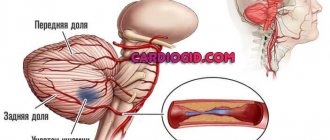
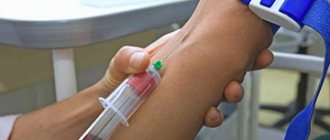



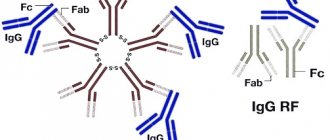
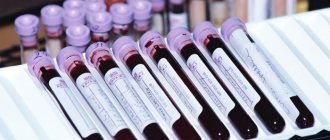

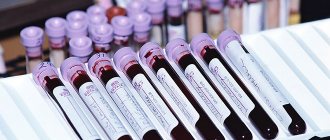
![Soluble insulin [human genetically engineered]: trade name, list of drugs](https://mcgaide.ru/wp-content/uploads/insulin-rastvorimyj-chelovecheskij-genno-inzhenernyj-torgovoe-nazvanie-perechen-preparatov-330x140.jpg)